A Content Delivery Network (CDN) is essential for optimizing website performance, offering benefits such as faster loading times, enhanced security, and improved reliability. By strategically distributing content across global servers, a CDN ensures users access data from the nearest location, significantly enhancing their experience. Implementing a CDN involves careful selection of a provider and configuration to maximize these performance gains.
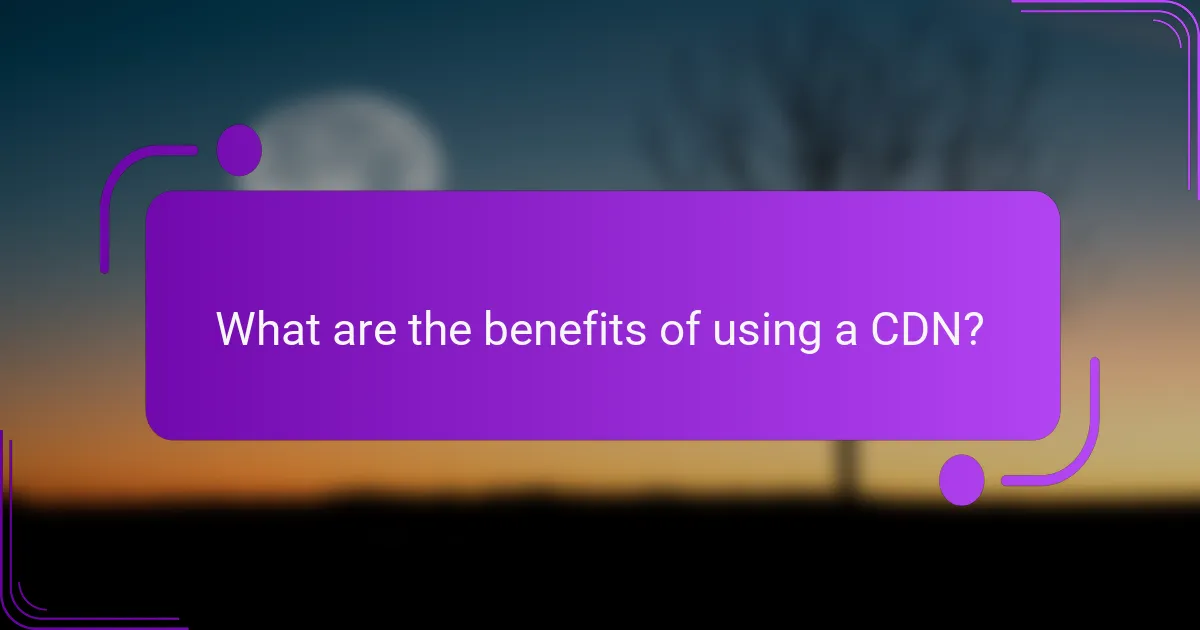
What are the benefits of using a CDN?
A Content Delivery Network (CDN) offers multiple advantages, including faster website loading times, enhanced security, and improved reliability. By distributing content across various servers worldwide, a CDN ensures that users receive data from the nearest location, optimizing performance and user experience.
Improved website loading speed
One of the primary benefits of a CDN is the significant improvement in website loading speed. By caching content on servers closer to users, CDNs reduce latency, often bringing load times down to low tens of milliseconds. This speed enhancement is crucial for retaining visitors and improving search engine rankings.
To maximize loading speed, choose a CDN that has a robust network of edge servers located in regions where your audience is concentrated. Regularly monitor performance metrics to ensure optimal delivery speeds.
Enhanced security features
CDNs provide enhanced security features that protect websites from various threats, including DDoS attacks and data breaches. Many CDNs offer built-in security protocols, such as Web Application Firewalls (WAF), which filter and monitor traffic for malicious activity.
Implementing a CDN can also help with compliance to regulations like GDPR, as it allows for better management of user data across different regions. Always check the security features of a CDN before implementation to ensure they meet your specific needs.
Increased reliability and uptime
Using a CDN increases website reliability and uptime by distributing content across multiple servers. If one server goes down, the CDN can reroute requests to another server, minimizing downtime and ensuring continuous access to your content.
For businesses, this reliability translates to better customer satisfaction and retention. Regularly assess your CDN provider’s uptime statistics to ensure they maintain high availability standards.
Global content delivery
A CDN enables global content delivery by caching content in various geographical locations. This means that users from different parts of the world can access your website with minimal delay, regardless of their distance from the origin server.
When selecting a CDN, consider its global reach and the locations of its edge servers. A well-distributed network will enhance the user experience for international visitors, making your content accessible and fast-loading worldwide.
Reduced bandwidth costs
CDNs can help reduce bandwidth costs by caching static content and serving it from edge servers. This decreases the amount of data that needs to be transmitted from the origin server, leading to lower data transfer costs.
To maximize savings, analyze your website’s traffic patterns and identify which content can be effectively cached. Many CDN providers offer pricing models based on usage, so choose one that aligns with your expected traffic to optimize costs.
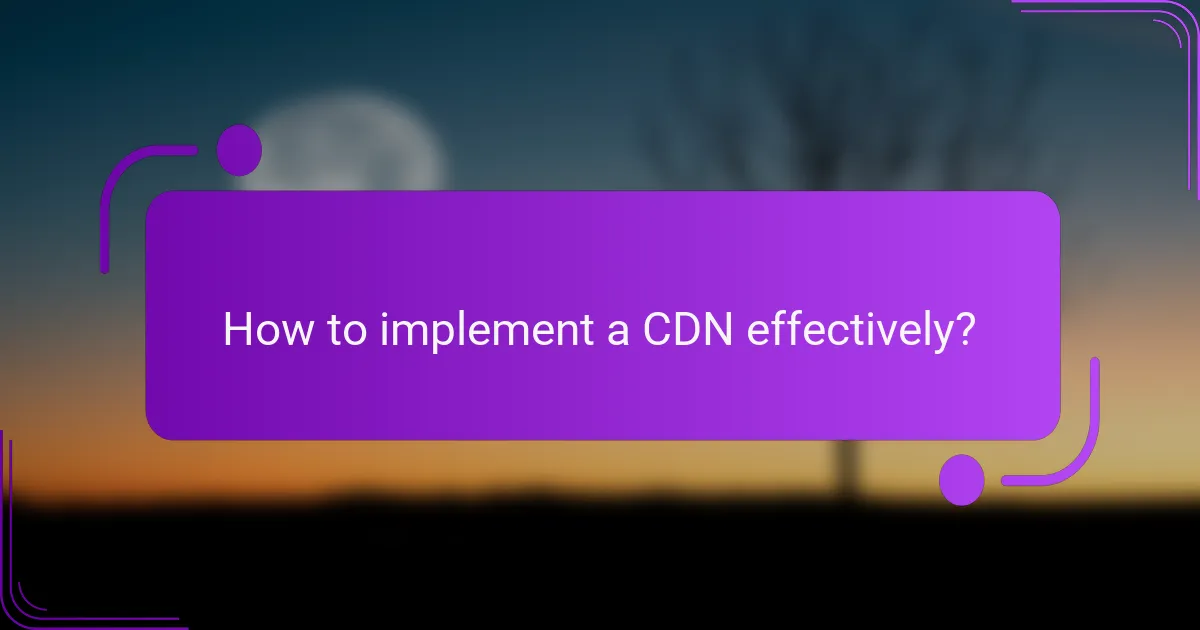
How to implement a CDN effectively?
Implementing a Content Delivery Network (CDN) effectively involves selecting the right provider, configuring your DNS settings, integrating with your existing infrastructure, and continuously testing and monitoring performance. Each step is crucial to ensure optimal delivery of content to users across various locations.
Choose the right CDN provider
Selecting the right CDN provider is essential for meeting your specific needs. Consider factors such as geographic coverage, scalability, pricing models, and the types of content you will be delivering. Popular providers include Cloudflare, Akamai, and Amazon CloudFront, each offering unique features and pricing structures.
Evaluate the performance metrics of potential providers, including latency, uptime, and customer support. Look for reviews and case studies that demonstrate their effectiveness in scenarios similar to yours.
Configure DNS settings
Proper DNS configuration is critical for routing user requests to the nearest CDN edge server. Start by updating your DNS records to point to the CDN provider’s servers, which may involve changing A records or CNAMEs. This step ensures that requests are efficiently directed, reducing latency.
Be mindful of DNS propagation times, which can vary from a few minutes to several hours. During this period, some users may still access your original server, so plan for potential inconsistencies in content delivery.
Integrate with existing infrastructure
Integrating the CDN with your existing infrastructure involves configuring your web servers and applications to work seamlessly with the CDN. This may include setting cache rules, adjusting headers, and ensuring that dynamic content is handled appropriately.
Utilize APIs provided by the CDN for automation and management. This can streamline processes like content purging and cache invalidation, making it easier to maintain up-to-date content across all locations.
Test and monitor performance
Regular testing and monitoring of your CDN’s performance are vital to ensure it meets your expectations. Use tools like Google PageSpeed Insights or GTmetrix to analyze load times and identify bottlenecks. Look for improvements in metrics such as Time to First Byte (TTFB) and overall page load speed.
Set up alerts for performance issues and regularly review analytics provided by your CDN. This proactive approach allows you to address problems quickly and optimize your content delivery strategy over time.
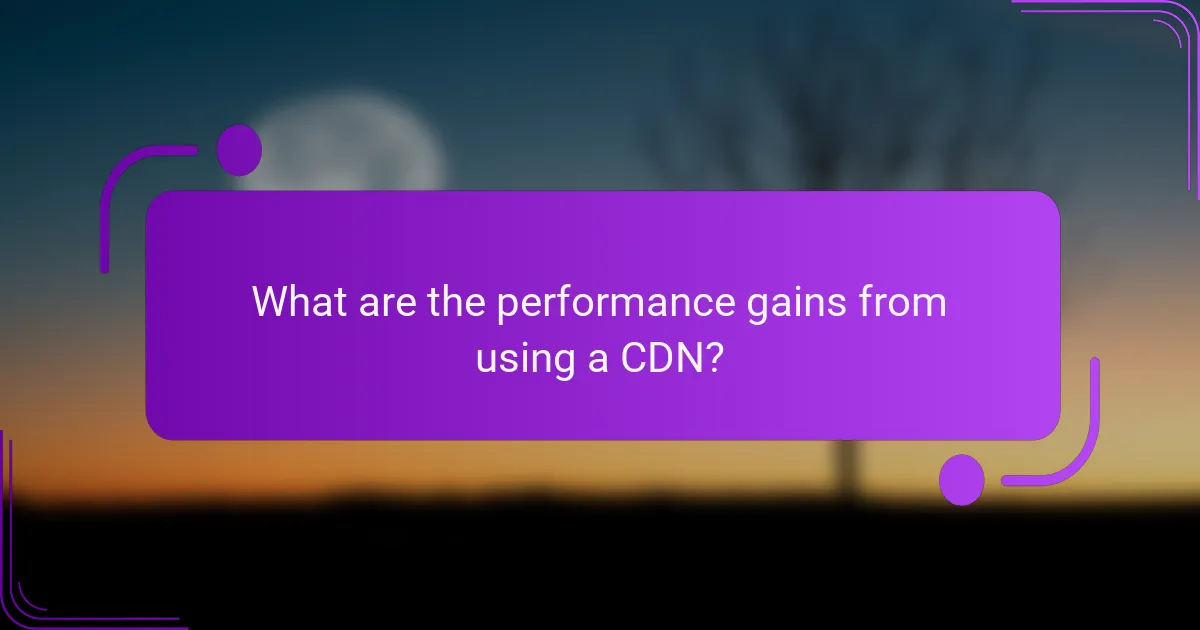
What are the performance gains from using a CDN?
Using a Content Delivery Network (CDN) can significantly enhance website performance by improving load times, reducing latency, and ensuring reliability during high traffic periods. These performance gains lead to a better user experience and can positively impact search engine rankings.
Faster content delivery times
CDNs store cached versions of your content across multiple geographically dispersed servers. When a user requests content, it is delivered from the nearest server, drastically reducing the distance data must travel. This can lead to load times that are often cut in half, especially for users located far from the original server.
For example, a user in Europe accessing a website hosted in the United States may experience delays of several seconds. With a CDN, that same user can receive content from a nearby European server, resulting in load times of just a few hundred milliseconds.
Lower latency for end users
Latency refers to the time it takes for data to travel from the server to the user. CDNs minimize latency by routing user requests to the closest edge server, which can significantly enhance the responsiveness of web applications. This is particularly important for real-time applications, such as online gaming or video conferencing, where even slight delays can disrupt the experience.
By utilizing a CDN, businesses can achieve latency reductions to low tens of milliseconds, ensuring that users enjoy a seamless interaction with their content, regardless of their location.
Scalability during traffic spikes
During traffic spikes, such as product launches or promotional events, a website can become overwhelmed by user requests. CDNs can absorb this increased load by distributing traffic across multiple servers, preventing crashes and maintaining performance. This scalability is crucial for businesses that experience fluctuating traffic patterns.
For instance, an e-commerce site can handle thousands of simultaneous users during a sale without degradation in performance, thanks to the CDN’s ability to balance the load effectively. This ensures that all users have a smooth experience, which can lead to higher conversion rates and customer satisfaction.
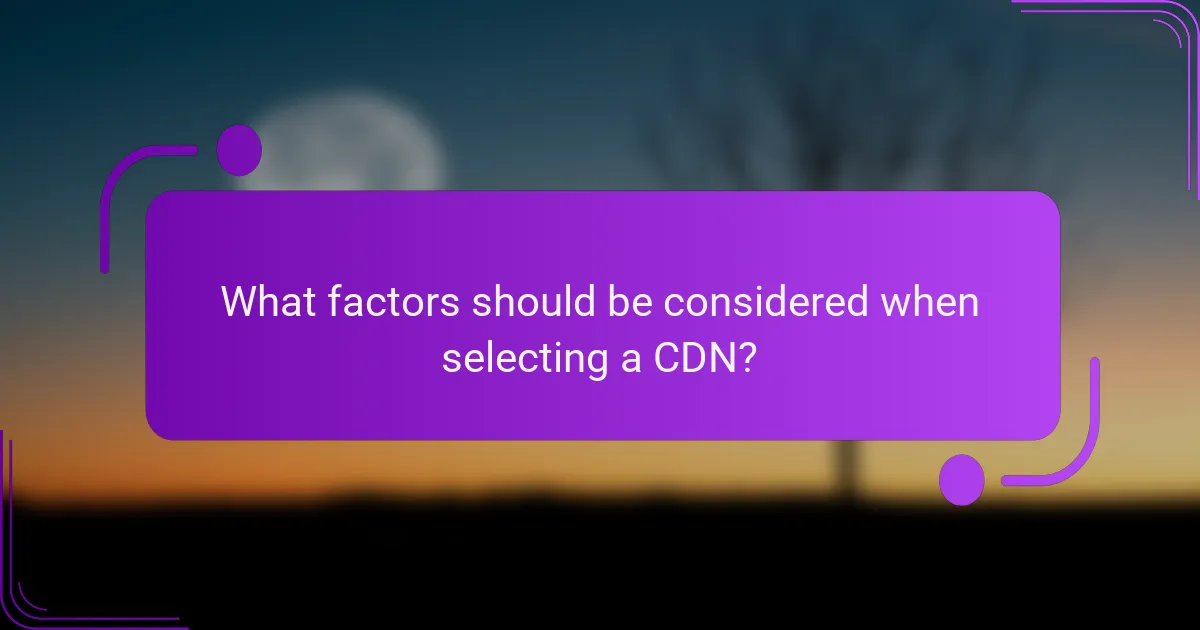
What factors should be considered when selecting a CDN?
When selecting a Content Delivery Network (CDN), consider factors such as geographic coverage, pricing models, and the level of support and customer service offered. These elements will significantly impact the performance, cost-effectiveness, and reliability of your CDN solution.
Geographic coverage
Geographic coverage refers to the number and distribution of data centers a CDN has around the world. A CDN with a broad network can deliver content more quickly to users by caching it closer to their location, reducing latency and improving load times.
When evaluating geographic coverage, check the CDN’s presence in regions where your audience is located. For example, if your primary users are in Europe, ensure the CDN has multiple points of presence (PoPs) across key countries to optimize performance.
Pricing models
CDNs typically offer various pricing models, including pay-as-you-go, monthly subscriptions, and tiered pricing based on usage. Understanding these models is crucial for budgeting and ensuring that the CDN aligns with your traffic patterns and growth projections.
Compare the costs associated with bandwidth, storage, and additional features like SSL certificates or DDoS protection. Some CDNs may offer free tiers for low usage, while others might charge based on data transfer rates, so evaluate what best fits your needs.
Support and customer service
Support and customer service are vital for resolving issues quickly and effectively. Look for CDNs that provide 24/7 support through multiple channels, such as live chat, email, and phone, to ensure you can get help when needed.
Additionally, consider the quality of the documentation and resources available. Comprehensive guides, FAQs, and community forums can significantly enhance your experience and help you troubleshoot problems independently.
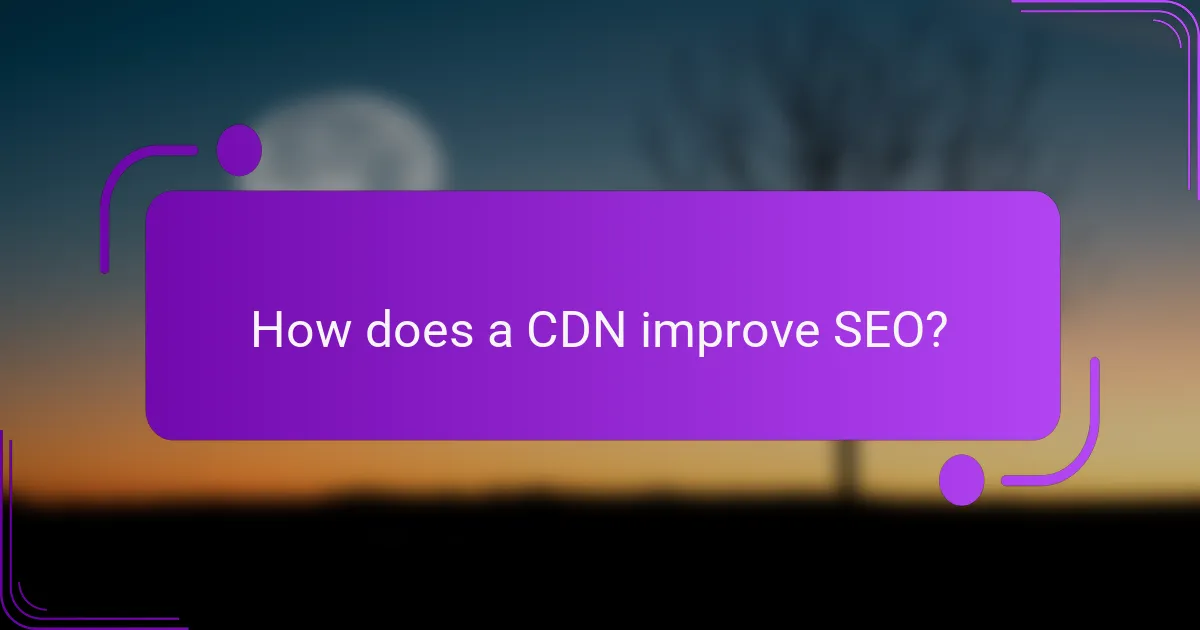
How does a CDN improve SEO?
A Content Delivery Network (CDN) enhances SEO by improving website loading speed and reliability, which are critical factors for search engine rankings. Faster load times lead to lower bounce rates and higher user engagement, both of which positively influence SEO performance.
Better user experience
A CDN provides a better user experience by distributing content across multiple servers located closer to users. This reduces latency and ensures that web pages load quickly, often within a few hundred milliseconds, which is crucial for retaining visitors.
Additionally, CDNs can handle traffic spikes effectively, preventing slowdowns during peak times. For example, if a website experiences a sudden surge in visitors, a CDN can distribute the load, maintaining performance and ensuring users do not encounter delays.
To maximize user experience with a CDN, ensure that your content is optimized for delivery. This includes compressing images and using modern formats like WebP, which can significantly reduce load times without sacrificing quality.
